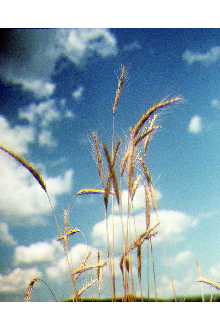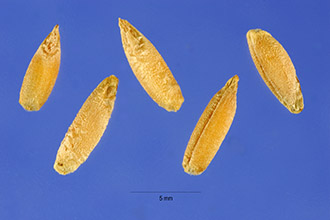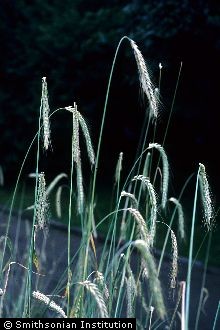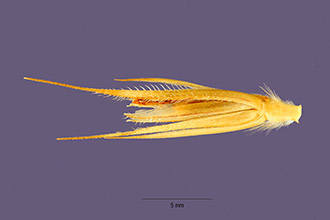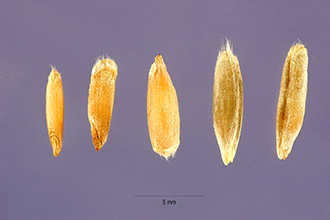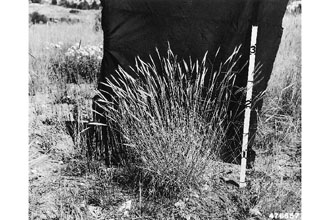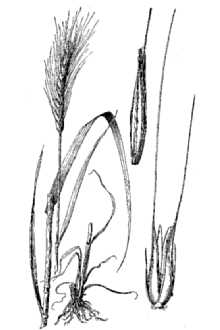Secale montanum Guss., nom. inq.
Scientific Name: Secale montanum Guss., nom. inq.
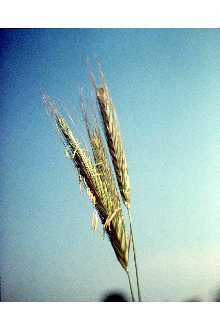
| General Information | |
|---|---|
| Usda Symbol | SEMO |
| Group | Monocot |
| Life Cycle | Annual |
| Growth Habits | Graminoid |
| Native Locations | SEMO |
Plant Guide
Alternate Names
Alternate Common Names: common rye, rye, winter rye, grain rye, cultivated rye Alternate Scientific Names: Secale montanum, Secale strictum, Triticum cereale
Uses
Cover crop and green manure: Cereal rye is often planted in the fall for soil erosion control (Oelke et al., 1990). As a cover crop, cereal rye can scavenge nitrogen, build soil, loosen topsoil (reduce compaction), prevent erosion, and suppress weeds. It can also be used as a livestock forage between cash crops. Cereal rye absorbs unused soil nitrogen (N) remaining from previously grown row crop. It typically assimilates 25-50 lb/acre N, but can retain as much as 100 lb/acre N (Clark, 2007). Cereal rye is compatible with multiple crop rotation systems in many regions. It can be used as a strip cover crop, overseeded, drilled, and/or broadcast. It overwinters well, and creates a physical barrier to weeds by producing large amounts of biomass (Clark, 2007). It also suppresses weeds chemically by producing allelopathic chemicals (Chase et al., 1991). Generally, cereal rye performs best as a cover crop or green manure crop if it is planted with other species, usually a legume. Grain: Cereal rye is grown as a grain crop for alcoholic beverages, food, livestock feed, and seed (Oelke et al., 1990). Rye flour can be used alone to make leavened bread, but it is more commonly mixed with wheat flour (Bushuk, 2001). Annual Pasture: Cereal rye can be grazed during the late fall or early spring when other forages are not available (Oelke et al., 1990). When used as grazed forage, cereal rye is usually mixed with other cool season species such as triticale. Hay: Cereal rye can be cut for hay when it is in the early heading stage of development (Oelke et al., 1990). It provides the best hay forage when it is grown with other species such as red or crimson clover, or annual ryegrass (Oelke et al., 1990). If used for forage production, cereal rye can contain up to 9% crude protein (Watson et al., 1993).
Status
Cereal rye is considered a Class C noxious weed in Washington. Please consult the PLANTS Web site and your State Department of Natural Resources for this plant’s current status (e.g., threatened or endangered species, state noxious status, and wetland indicator values).
Weediness
Cereal rye has the potential to become a weed if it is allowed to produce mature seed (Clark, 2007). It can be killed with herbicides, mowing, chopping, or roller crimping at the correct growth stage (Clark, 2007; Oelke et al., 1990). Please consult with your local NRCS Field Office, Cooperative Extension Service office, state natural resource, or state agriculture department regarding its status and use. Weed information is also available from the PLANTS Web site at http://plants.usda.gov/. Please consult the Related Web Sites on the Plant Profile for this species for further information.
Ethnobotany
English and Dutch settlers brought cereal rye to the northeastern United States. Flour made from cereal rye is gluten free (Oelke et al., 1990), which makes it an ideal flour for people with celiac disease. It has been historically grown in the North Central states of South Dakota, Nebraska, North Dakota, and Minnesota (Oelke et al., 1990). The witch hunts and executions that have occurred throughout history may have been the result of a misdiagnosis of rye ergot poisoning (Matossian, 1989). Many of the symptoms of ergot poisoning, such as
Description
Cereal rye is an upright, cool season, annual grass. It can grow 3 to 6 feet tall, has flat leaf blades, and is topped with awned flower spikes called heads. Distribution: Cereal rye is found in most of the continental U.S. and in Alaska. It is a cultivated introduced species that is thought to have originated from Eurasia (Yatskievych, 1999). For current distribution, please consult the Plant Profile page for this species on the PLANTS Web site. Habitat: Cereal rye is able to grow in a wide variety of climate and soil conditions. In most areas it does not persist well when it escapes cultivation. It grows best when cultivated in light loams or sandy soils, but it will also do well in clay soils. Some varieties can tolerate waterlogging while others do well in dry soils (Clark, 2007).
Adaptation
Cereal rye is a cultivated plant and in most regions it does not persist very long in the wild. There are many varieties of cereal rye on the market, each of which is best adapted to a particular geographic area, climate, and soil conditions (Clark, 2007; Oelke et al., 1990). To find the right variety or cultivar for use in your area contact your local NRCS office or Extension Service.
Establishment
Establishment methods and timing of planting depends on the management objective of the producer. Cereal rye is planted from late summer to midwinter depending on the geographic region (Clark, 2007). Seed should be planted no deeper than 2 inches (Clark, 2007). Cereal rye seed can be drilled, over-seeded into an existing crop, or broadcasted. Seeding rates vary from 50–200 lb/ac, depending on climate and use. It can be planted alone or with other species. For the best seeding rates, methods, and practices for your area contact your local NRCS office or Extension Service.
Management
Management of cereal rye can vary widely. It can be managed to produce a grain crop to mill for flour, where it can be harvested and threshed using a combine (Oelke et al., 1990). In a cover crop or green manure system, a multitude of management options are available. It can be killed at different times for weed suppression, to prevent nitrogen uptake, or incorporated into soil for organic matter build up. It can be terminated by plowing, disking, mowing, roller crimping, or with herbicides.
Pests and Potential Problems
Cereal rye is susceptible to some diseases, although it is generally more resistant than other cereal species (Oelke et al., 1990). Ergot, stem or stalk smut, anthracnose, and various rusts of the leaves or stem are the most likely disease problems that will be encountered (Oelke et al., 1990). In the spring, armyworm moths are attracted to cereal rye and may lay eggs on it (MCCC, 2012). It is important to not feed ergot infected rye to humans or animals as it could result in ergotism, which can cause convulsions, miscarriage, hallucinations, and gangrene of the arms, legs, fingers, and toes.
Environmental Concerns
Concerns
Concerns
Caution should be used when planting cereal rye before winter wheat, because volunteer rye could become a weed in the wheat crop. Cereal rye is listed as a Class C noxious weed in Washington and should not be used there.
Control
Please contact your local agricultural extension specialist or county weed specialist to learn what works best in your area and how to use it safely. Always read label and safety instructions for each control method.
Seeds and Plant Production
Plant Production
Plant Production
For seed production, the seedbed should be smooth, firm, and weed free, Seeds should be planted 1 to 1, Use soil moisture sensors to measure the soil moisture of Secale montanum Guss., nom. inq..,5 inches deep (Government of Alberta, 2011), Seeding rate will vary depending on climatic conditions and variety of rye that is being used, Typical rates average 55-60 lb/acre (Government of Alberta, 2011), Soil tests can determine the amount and timing of any fertilizer application, but can be up to 50 lb N/acre (Government of Alberta, 2011), Rye shatters very easily, It is recommended to swath when moisture is around 40%, dry, and then feed through a combine or thresher to separate the seed from the chaff (Government of Alberta, 2011), Cultivars, Improved, and Selected Materials (and area of origin) Several cultivars of cereal rye are readily available for different geographical regions, climates, soil types, and use, Common varieties of cereal rye are ‘Elbon’, Noble Foundation , Ardmore, Oklahoma; ‘Hancock’, Wisconsin Agricultural Experiment Station; ‘Musketeer’, Agriculture Canada; ‘Rymin’, Minnesota Agricultural Experiment Station; ‘Aroostook’, USDA-NRCS, Cornell University, and Maine Dept, of Agriculture; ‘Cougar’, University of Manitoba; ‘Dankowski Nowe’ (Danko), Dankow-Laski and Choryn experiment stations; ‘Frederick’, South Dakota Agricultural Experiment Station; ‘Metzi’, Nutriseed Company; ‘Puma’, University of Manitoba; and ‘Von Lochow’, obtained from F, Von Lochow-Petkus Ltd, of Germany and released by Minnesota Agricultural Experiment Station; ‘Prima’, used in Canada and is ergot resistant; ‘AC Remington’, used in Canada and is ergot resistant; ‘Maton’; ‘Rosen’; ‘Dakold’, To find the right variety or cultivar for use in your area contact your local NRCS office or Extension Service,
References
Bushuk, W. 2001. Rye production and uses worldwide. Cereal Foods World 46:70-73. Chase, W.R., M.G. Nair, and A.R. Putnam. 2,2’-OXO- 1,1’-Azobenzene: selective toxicity of rye (Secale cereale L.) allelochemicals to weed and crop species: II. Journal of Chemical Ecology 17:9-19. Clark, A. (ed.) 2007. Managing cover crops profitably. 3rd ed. Sustainable Agriculture Research and Education (SARE) Handbook Series Book 9. Sustainable Agriculture Research and Education (SARE) Program, College Park, MD. Government of Alberta. 2011. Fall rye production http://www1.agric.gov.ab.ca/$department/deptdocs.nsf/all/agdex1269 (verified May 2012). Government of Alberta Agriculture and Rural Development. Edmonton, Alberta. Matossian, M.K. 1989. Poisons of the past. Yale Univ. Press, New Haven. MCCC (Midwest Cover Crops Council). 2012. Midwest Cover Crops Field Guide. http://plantcovercrops.com/category/types-of-cover-crops/winter-cereal-rye/ (verified May 2012). Oelke, E.A., E.S. Oplinger, H. Bahri, B.R. Durgan, D.H. Putnam, J.D. Doll, and K.A. Kelling. 1990. Rye. In: Alternative field crops manual [Online]. www.hort.purdue.edu/newcrop/afcm/ (verified May 2012). Univ. of Wisconsin-Extension and Univ. of Minnesota. Watson, S., D.L. Fjell, J.P. Shroyer, K. Bolsen, and S. Duncan. 1993. Small grain cereals for forage. Kansas State Univ., Manhattan. Yatskievych, G. 1999. Steyermark’s flora of Missouri: volume 1. Missouri Dept. of Conservation, Jefferson City. Prepared By: P. Allen Casey, USDA-NRCS Elsberry Plant Materials Center, Missouri Citation Casey, P.A. 2012. Plant guide for cereal rye (Secale cereale). USDA-Natural Resources Conservation Service, Plant Materials Center, Elsberry, MO. Published: May 2012 Edited:03May2012 plsp; 09May2012 aym, 23May2012 cs, For more information about this and other plants, please contact your local NRCS field office or
Fact Sheet
Uses
Cereal rye is a commonly used winter cover crop in the northeastern U.S. Due to the late harvest of many crops, fall-planted cover crops often do not make adequate growth to provide winter soil protection, but cereal rye can germinate and grow under cooler conditions than other covers. Cereal rye can also be used for spring forage production, and fed as pasture, green chop, or put up as haylage. It is reported that rye forage may impart an off-flavor to milk. Cereal rye does have an allelopathic affect on some weed species.
Status
Please consult the PLANTS Web site and your State Department of Natural Resources for this plant’s current status (e, Use soil moisture sensors to measure the soil moisture of Secale montanum Guss., nom. inq..,g, threatened or endangered species, state noxious status, and wetland indicator values),
Weediness
This plant may become weedy or invasive in some regions or habitats and may displace desirable vegetation if not properly managed. Please consult with your local NRCS Field Office, Cooperative Extension Service office, or state natural resource or agriculture department regarding its status and use. Weed information is also available from the PLANTS Web site at plants.usda.gov.
Description
Cereal rye is an erect annual grass, with flat leaf blades and dense flower spikes. Each large spike consists of many 2-flowered spikelets with long awns. The grain is relatively large, typically around ½ inch long. There are 18,000 seeds per pound.
Adaptation and Distribution
Distribution
Distribution
The cultivar ‘Aroostook’ is expected to produce a satisfactory stand as a late seeded cover crop if a minimum of 260-350 growing degree days (base 40 degrees F) remain after seeding. While ‘Aroostook’ was developed primarily for use in northern climates, it is widely adapted as a cover crop and forage producer outside the Northeast. Cereal rye is distributed throughout the United States. For a current distribution map, please consult the Plant Profile page for this species on the PLANTS Website. USDA NRCS National Plant Materials Center Beltsville, MD
Establishment
The best method to plant ‘Aroostook’ following potatoes, corn, soybeans, and other row crops, is to drill the seed one inch deep using a conventional grain drill equipped with packer wheels. Another satisfactory method is to broadcast the seed followed by a shallow disking or harrowing and cultipacking. Use a minimum of 2 bushels per acre (110 to 120 lb/acre). ‘Aroostook’ rye can also be aerial seeded in standing corn or other row crops. Aerial seeding is very dependent on favorable weather for success. For very late plantings or aerial seedings, 3 bushels per acre is recommended. No seed treatment is recommended.
Management
There is usually adequate residual fertilizer following a row crop to produce the cover crop. Due to ‘Aroostook’s abundant spring growth, it is important to plow, spray, graze, or cut its stands in a timely manner when managed for green manure, cover crop, or forage. Strong growth can be anticipated in March in the southern part of the Northeast. Northern locations typically begin growth in April. For pasture, extremely rapid rotation or stocking with large numbers of animals is required to capture the spring growth. In areas with high nitrogen availability, take preventative measures for grass tetany or other related reactions; an acclimation period for livestock is highly recommended.
Pests and Potential Problems
This section is under development. Cultivars, Improved, and Selected Materials (and area of origin) Late fall and early spring growth, and prostrate fall leaf growth make ‘Aroostook’ (New York) rye a valuable cover crop. ‘Aroostook’ rye can be seeded in northern Maine as late as September 30th. The leaf area index, (when the plants are growing at 200 growing degree days with a base of 32 degrees F) is significantly greater than ‘Balbo.’ The foundation seed for ‘Aroostook’ rye is produced by the Big Flats, NY Plant Materials Center, and is available to commercial seed producers. Commercially produced certified seed is available from some dealers. Currently, most seed production occurs in the Midwest.
Plant Traits
Growth Requirements
| CaCO3 Tolerance | Medium |
|---|---|
| Frost Free Days, Minimum | 90 |
| Frost Free Days, Minimum | 110 |
| Fire Tolerance | None |
| Fire Tolerance | Medium |
| Fertility Requirement | Medium |
| Fertility Requirement | Medium |
| Drought Tolerance | Medium |
| Drought Tolerance | Medium |
| Cold Stratification Required | No |
| Cold Stratification Required | No |
| Temperature, Minimum (°F) | -43 |
| CaCO3 Tolerance | Medium |
| Anaerobic Tolerance | None |
| Anaerobic Tolerance | None |
| Adapted to Medium Textured Soils | Yes |
| Adapted to Medium Textured Soils | Yes |
| Adapted to Fine Textured Soils | No |
| Adapted to Fine Textured Soils | No |
| Adapted to Coarse Textured Soils | Yes |
| Adapted to Coarse Textured Soils | Yes |
| Hedge Tolerance | None |
| Temperature, Minimum (°F) | -33 |
| Shade Tolerance | Intolerant |
| Shade Tolerance | Intolerant |
| Salinity Tolerance | Medium |
| Salinity Tolerance | Medium |
| Root Depth, Minimum (inches) | 8 |
| Root Depth, Minimum (inches) | 8 |
| Precipitation, Minimum | 8 |
| Precipitation, Minimum | 15 |
| Precipitation, Maximum | 50 |
| Precipitation, Maximum | 50 |
| pH, Minimum | 5.2 |
| pH, Minimum | 4.5 |
| pH, Maximum | 8.2 |
| pH, Maximum | 7.5 |
| Moisture Use | High |
| Moisture Use | High |
| Hedge Tolerance | None |
Morphology/Physiology
| Active Growth Period | Spring, Summer, Fall |
|---|---|
| Toxicity | None |
| Toxicity | None |
| Shape and Orientation | Erect |
| Shape and Orientation | Erect |
| Fall Conspicuous | No |
| Foliage Porosity Summer | Moderate |
| Foliage Porosity Summer | Moderate |
| Foliage Color | Green |
| Foliage Color | Green |
| Flower Conspicuous | No |
| Flower Conspicuous | No |
| Flower Color | Yellow |
| Flower Color | Yellow |
| Fire Resistant | No |
| Fire Resistant | No |
| Fall Conspicuous | No |
| Resprout Ability | No |
| Coppice Potential | No |
| Coppice Potential | No |
| C:N Ratio | Medium |
| C:N Ratio | Medium |
| Bloat | None |
| Bloat | None |
| After Harvest Regrowth Rate | Slow |
| After Harvest Regrowth Rate | Moderate |
| Active Growth Period | Spring, Summer, Fall |
| Resprout Ability | No |
| Foliage Porosity Winter | Moderate |
| Nitrogen Fixation | None |
| Nitrogen Fixation | None |
| Low Growing Grass | No |
| Low Growing Grass | No |
| Leaf Retention | No |
| Leaf Retention | No |
| Known Allelopath | Yes |
| Known Allelopath | Yes |
| Height, Mature (feet) | 3.5 |
| Height, Mature (feet) | 3.5 |
| Growth Rate | Rapid |
| Growth Rate | Rapid |
| Foliage Porosity Winter | Moderate |
| Foliage Texture | Fine |
| Foliage Texture | Fine |
| Fruit/Seed Color | Brown |
| Fruit/Seed Color | Brown |
| Fruit/Seed Conspicuous | No |
| Fruit/Seed Conspicuous | No |
| Growth Form | Bunch |
| Growth Form | Bunch |
Reproduction
| Propagated by Cuttings | No |
|---|---|
| Propagated by Seed | Yes |
| Propagated by Seed | Yes |
| Propagated by Sod | No |
| Propagated by Sod | No |
| Propagated by Sprigs | No |
| Propagated by Sprigs | No |
| Propagated by Tubers | No |
| Propagated by Tubers | No |
| Fruit/Seed Persistence | No |
| Seed per Pound | 18160 |
| Seed per Pound | 18160 |
| Seed Spread Rate | Slow |
| Seed Spread Rate | Slow |
| Seedling Vigor | High |
| Seedling Vigor | Medium |
| Small Grain | Yes |
| Small Grain | Yes |
| Vegetative Spread Rate | None |
| Vegetative Spread Rate | None |
| Propagated by Corm | No |
| Propagated by Cuttings | No |
| Bloom Period | Early Spring |
| Bloom Period | Early Spring |
| Commercial Availability | Routinely Available |
| Commercial Availability | Routinely Available |
| Fruit/Seed Abundance | High |
| Fruit/Seed Abundance | High |
| Fruit/Seed Period Begin | Spring |
| Fruit/Seed Period Begin | Spring |
| Fruit/Seed Period End | Summer |
| Fruit/Seed Persistence | No |
| Propagated by Bare Root | No |
| Propagated by Bare Root | No |
| Propagated by Bulb | No |
| Propagated by Bulb | No |
| Propagated by Container | No |
| Propagated by Container | No |
| Propagated by Corm | No |
| Fruit/Seed Period End | Summer |
Suitability/Use
| Palatable Browse Animal | High |
|---|---|
| Palatable Graze Animal | High |
| Palatable Graze Animal | High |
| Palatable Human | Yes |
| Palatable Human | Yes |
| Post Product | No |
| Post Product | No |
| Protein Potential | Medium |
| Protein Potential | Medium |
| Pulpwood Product | No |
| Pulpwood Product | No |
| Veneer Product | No |
| Veneer Product | No |
| Palatable Browse Animal | High |
| Nursery Stock Product | No |
| Nursery Stock Product | No |
| Naval Store Product | No |
| Naval Store Product | No |
| Lumber Product | No |
| Lumber Product | No |
| Fodder Product | Yes |
| Fodder Product | Yes |
| Christmas Tree Product | No |
| Christmas Tree Product | No |
| Berry/Nut/Seed Product | No |
| Berry/Nut/Seed Product | No |

